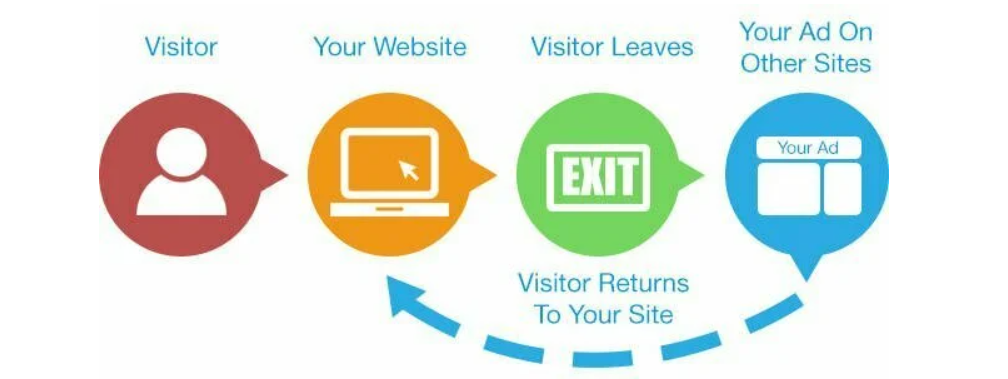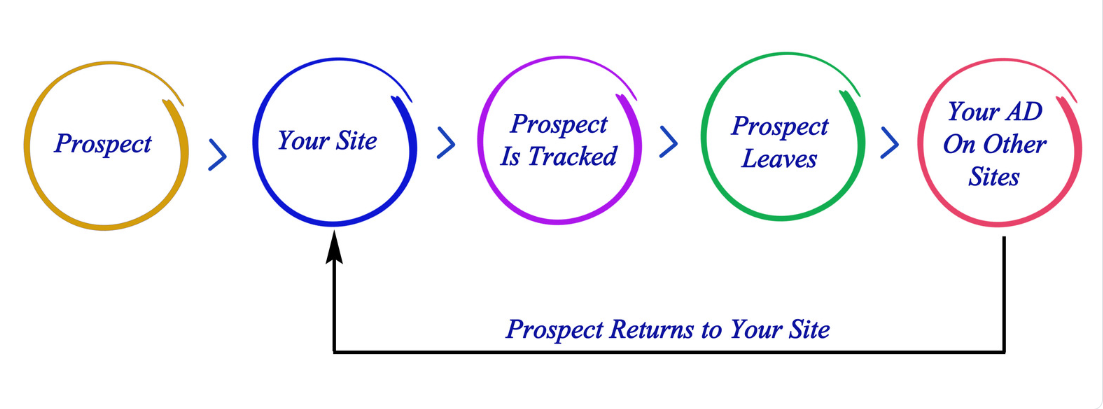Have you ever seen that cool gadget online, only to have ads for it follow you everywhere? That's retargeting, but it's way cooler than it sounds!
In our blog, we will be talking about;
- The retargeting concept and history
- The anatomy of retargeting ads
- The psychology behind retargeting
- Why you should use retargeting?
- Exploring the many possibilities of retargeting ads
- How to implement a retargeting campaign
- Bonus tips and conclusion
A Little Bit About Retargeting Concept and History
Imagine a friendly market seller remembering you liked a scarf and reminding you later. Retargeting started like that in the 1990s, way before fancy terms like "AI" existed. Back then, it was just simple ads based on what you looked at online.
While the term "retargeting" emerged in the early 2000s, the concept dates back further. Think of a shopkeeper remembering your interest in a specific scarf and showing it again later. In 1997, AdKnowledge became the first to translate this offline tactic to the digital world, allowing advertisers to "follow" potential customers across websites. In 1999, Advertising.com also launched its retargeting services. Only in 2002, that Google launch its first customer retargeting program.
Early retargeting was simple, displaying static ads based on browsing history. But with time, like all digital services and ads, retargeting evolved. Interactive formats, dynamic personalization, and AI-powered optimization became the secret ingredients.
From targeting "almost buyers" to leveraging lookalike audiences, retargeting now extends across industries, platforms, and the entire customer journey. Privacy concerns became a hurdle, but transparency and ethical data practices paved the way for responsible storytelling.
Today, retargeting isn't just a reminder, it's a tailored narrative, that guides users towards their desired purchase. The future promises even more immersive experiences, like voice-activated ads whispering tempting offers.

The Anatomy of Retargeting Ads
Retargeting ads operate on a simple yet ingenious principle: they target individuals who have previously interacted with your website, app, or other digital channels but haven't taken the desired action, whether it's making a purchase, filling out a form, or signing up for a newsletter.
Here's how it works:
- Tracking User Behavior: The journey begins by placing a pixel or tracking code on your website, which discreetly monitors visitors' actions. This code captures crucial data such as pages viewed, products added to the cart, and duration of the visit.
- Building Audience Segments: Based on the collected data, sophisticated algorithms categorize users into segments or groups, reflecting their behavior and level of engagement. For instance, someone who abandoned their cart may belong to a segment labeled "Cart Abandoners."
- Crafting Tailored Ads: With insights about these segments, advertisers create targeted ads designed to reignite the interest of lost prospects. These ads may showcase the exact products or services the user showed interest in or present compelling offers to entice them back.
- Deploying Across Channels: Retargeting ads can appear across various digital channels, including social media platforms, display networks, search engines, and even email. This omnipresence ensures that no stone is left unturned in the quest to re-engage with potential customers.
- Optimizing: The beauty of retargeting lies in its adaptability. Marketers continuously monitor ad performance, tweaking elements such as ad copy, imagery, and targeting parameters to maximize effectiveness and drive conversions.

The Psychology Behind Retargeting
Retargeting works by using familiarity and repetition to encourage people to take action. When you see ads for brands or products you've already looked at, it reminds you of them and helps you trust the brand more.
There's a psychological idea called the "mere exposure effect." It means the more you see something, the more you like it. With retargeting, seeing ads multiple times can make you more likely to go back to a website and buy something.

Why You Should Use Retargeting?
This psychological effect and the effectiveness of retargeting campaigns can be noticed by their results:
1. More Clicks, More Conversions:
Retargeting boasts a click-through rate (CTR) 10x higher than traditional display ads (Invespcro, 2024). That means people are 3 times more likely to click on a retargeted ad (Spiralytics, 2024). And guess what? Clicking translates to conversions: retargeting can increase conversion rates by 150% (99firms, 2024).
2. More Affordable, More ROI:
Compared to search ads, retargeting ads have an average CPC (cost-per-click) reduced by nearly half (AdRoll, 2023). Think about it: you're reaching people who already showed interest, so they're cheaper to convert. This translates to a better return on investment, making retargeting a budget-friendly powerhouse.
3. More Personalized, More Resonant:
Forget generic ads. Retargeting allows you to personalize messages based on individual browsing history and preferences. This deeply relevant approach resonates with users: 65% of online viewers consider retargeted ads they notice (Pilipenko, 2021). That's an engagement you can't miss!
4. More Sophisticated, More Powerful:
Gone are the days of simple retargeting. Today, tools use AI to personalize ad formats, optimize bidding strategies, and even predict customer behavior. This advanced approach ensures you reach the right people with the right message at the right time, maximizing impact.
Exploring the Many Possibilities of Retargeting Ads
In essence, retargeting is not just about recapturing lost clicks; it's about fostering meaningful connections, nurturing relationships, and guiding prospects along the path to purchase.
Let’s explore a few possibilities of retargeting usage:
1. Website Visitors: Remember someone browsing your online store but leaving empty-handed? Retarget them with a gentle reminder, showcasing those tempting products again.
2. Cart Abandoners: They almost bought that jacket, but something stopped them. Retarget them with a special offer or highlight free shipping to nudge them back to checkout.
3. Email Subscribers: Already know their email, but want to grab their attention? Retarget them with visually appealing ads based on their interests or past purchases.
4. Lookalike Audiences: Expand your reach by targeting people similar to your existing customers. Think of it as finding more hiking boot enthusiasts like the ones you already know.
5. Dynamic Remarketing: Show users the exact products they viewed, personalized recommendations, or even abandoned cart contents as a persistent reminder.
6. Video Remarketing: Captivate viewers who interacted with your video ads with targeted follow-up ads on YouTube or other platforms.
7. Search Remarketing: When someone searches for something related to your business, appear at the top of their search results with a relevant ad.
8. App Remarketing: Remind users who downloaded your app but aren't using it regularly to come back and explore its features.
9. Sequential Retargeting: Craft a multi-stage advertising journey. First, pique interest with a general ad. Then, for those who engage, deliver targeted product recommendations or special offers, guiding them towards purchase like a patient storyteller.
10. Geofencing Retargeting: Imagine targeting people who visited your physical store with ads on their phones when they're nearby.
11. Cross-Device Retargeting: Someone browses on their laptop, adds to cart on their tablet, and abandons on their phone. No worries! Cross-device retargeting follows them across devices, ensuring your message reaches them wherever they are.
12. Retargeting Based on Offline Behavior: Imagine targeting people who attended an event or interacted with your brand offline with relevant online ads. Retargeting bridges the gap between the physical and digital worlds.
How to Implement a Retargeting Campaign
Step 1: Define Your Goals & Audience: What do you want to achieve? (increased brand awareness, website traffic, product sales, etc.) Who are you targeting? (existing customers, website visitors, specific demographics, etc.)
Step 2: Choose Your Platform: Popular options include Google Ads, Facebook Ads, Twitter Ads, and specialized retargeting platforms. Research each platform's features, audience reach, and pricing to find the best fit.
Step 3: Set Up Your Retargeting Pixel: This code snippet goes on your website and tracks user behavior, creating the foundation for retargeting. Each platform has specific instructions for pixel installation.
Step 4: Build Your Target Audiences: Define audience segments based on your goals. Consider website visitors, cart abandoners, specific product viewers, email subscribers, etc. Platforms offer various targeting options like demographics, interests, and purchase history.
Step 5: Craft Compelling Ad Creatives: Go beyond static images! Explore engaging formats like video ads, interactive quizzes, or personalized product recommendations. Communicate, clearly, your message and offer, aligning with your target audience and campaign goals.
Step 6: Set Your Budget & Bidding Strategy: Decide how much you're willing to spend and how you want to pay for clicks or impressions. Each platform offers different bidding options like manual, automated, and optimized strategies.
Step 7: Launch Your Campaign & Monitor Performance: Track key metrics like impressions, clicks, conversions, and return on investment (ROI). Analyze data and adjust your targeting, creatives, or bidding strategy for better results.

Bonus Tips
- Start small and experiment with different targeting options and ad formats.
- A/B test different variations of your creatives to see what performs best.
- Stay compliant with data privacy regulations and be transparent with your audience.
Last, but not least;
Remember, retargeting is a powerful tool, but it requires planning and ongoing optimization. By following these steps and leveraging your creativity, you can launch effective campaigns that resonate with your audience and drive real results. Now go forth and retarget with confidence!
Now's the time to capitalize on untapped potential. Embrace retargeting as your strategic tool for driving conversions. Craft precise ads, monitor diligently, and refine for optimal performance. This is your opportunity to enhance engagement and elevate your ROI. Let's retarget and achieve exceptional results!
If you would like to know more about retargeting and how you can apply it to your business, NMQ Digital is here to support you with its Performance Marketing Services.






